Index


Review: Fingers crossed for Nvidia's response to AMD's price cuts
Gainward's Fermi-based Phantom series has received much praise and attention but Kepler is here and it's time to move forward. For the time being, the GPU only powers GTX 680 cards but thankfully, Gainward's Phantom is aimed at high-end cards to begin with. So, our today's guest is Gainward's GTX 680 Phantom graphics card.
Gainward's offer already boasts three GTX 680 graphics cards and we hear that a new GTX 680 Phantom is around the corner, this time with 4GB of memory. This should be interesting news, since reference GTX 680 cards come with 2GB of memory, but extreme resolutions suggest that the GTX 680 would prefer a larger buffer.
The Phantom card we tested comes with reference 2GB of memory, which is factory overclocked just like the GPU.
Note that reference GPU clock is 1006MHz whereas the Phantom runs at 1085MHz. The card's memory runs at 1575MHz, which is 73MHz (292MHz effcetively) higher than reference.
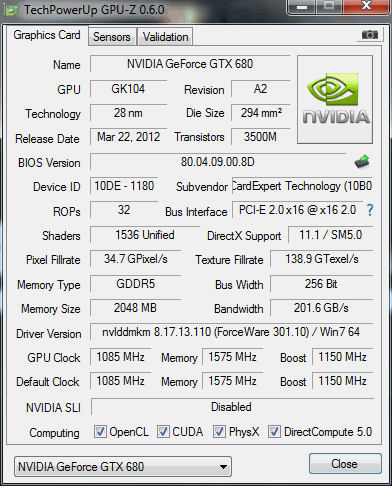
Although factory overclocking is a welcome addition, we believe that it's the card's cooling that will attract users even more. According to Gainward's internal tests, Phantom cooling should be up to 6°C cooler and up to 11.5 dB quieter.
Of course, we'll check these results but we're pretty sure we will only confirm them. Quite expectedly, since Gainward used a two and a half slots wide heatsink with two fans.
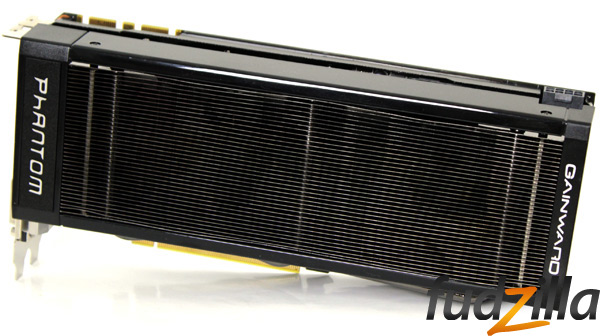
We found Gainward’s packaging to be quite nice, as the company included a handle as well.
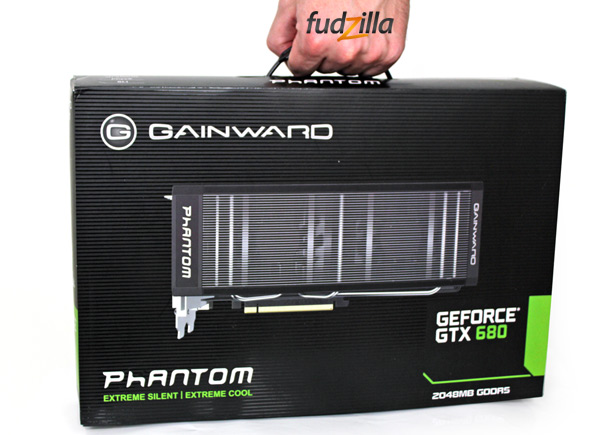
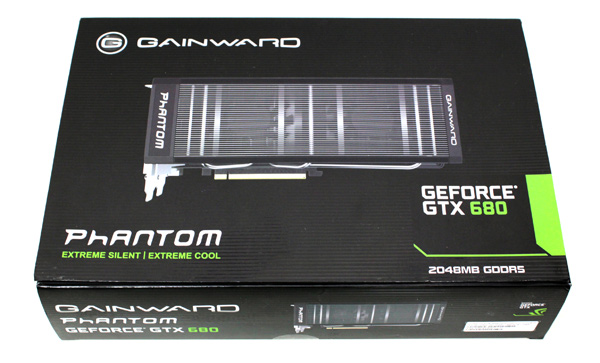
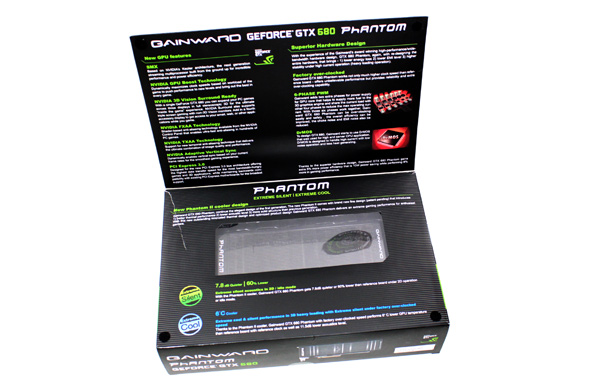
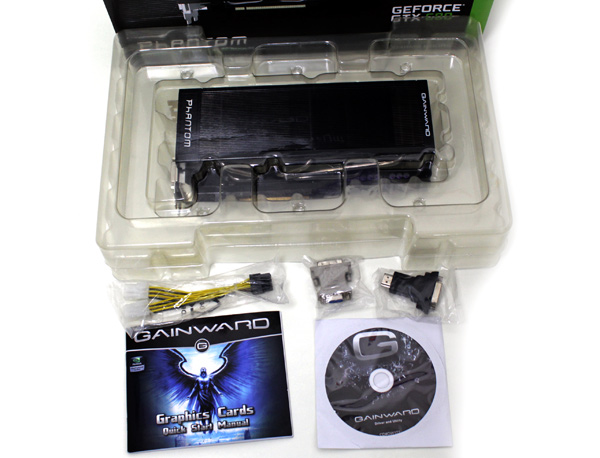
GTX 680's Phantom cooler is different from the one used on GTX 580 cards, although the cards may seem identical at a glance. The new cooler kept the 2.5 slot width. However, removing the shroud reveals that the new Phantom cooler uses only two fans but takes advantage of the new heatsink's larger dissipation surface. Note that the GTX 580 Phantom used three fans.

Two 8cm PWM fans are tucked away in a special chamber within the heatsink.
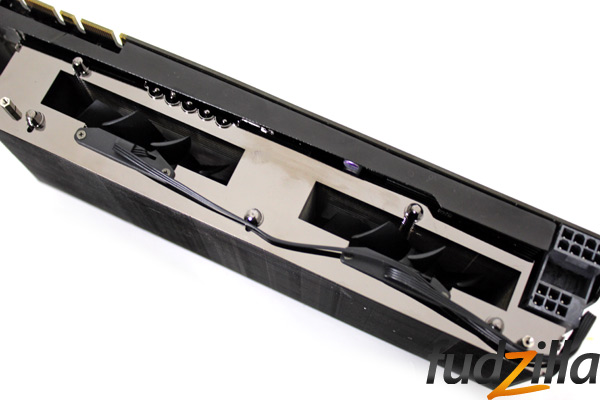
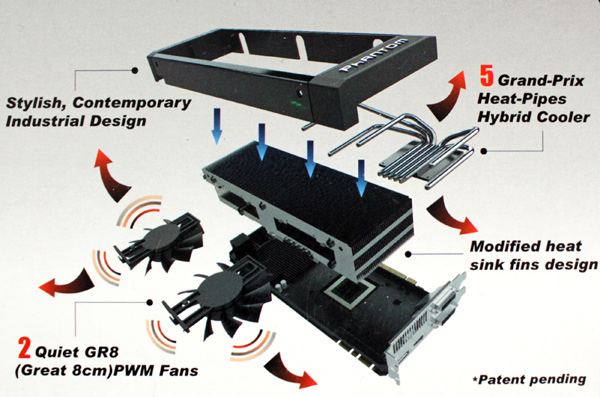
Below are some pics of GTX 580 Phantom and its cooler.
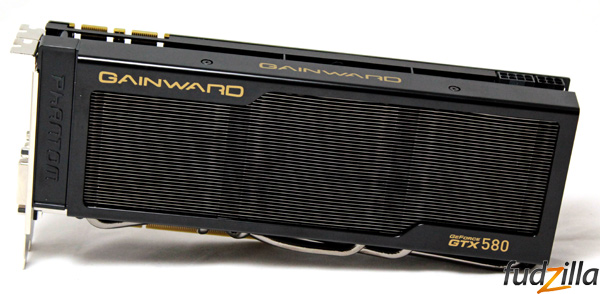

The only thing we didn’t like on GTX 580 Phantom’s cooler was the noise. Although the fans weren’t too loud, reference GTX 580 cards were slightly quieter. It goes without saying that Gainward’s solution performed better. Compared to the reference GTX 680, Gainward’s GTX 680 Phantom on the other hand brings noticeably quieter operation and superior cooling in one package.
A five-heatpipe system is used to take care of heat transfer between the cooler base and the heatsink. As you can see from the picture below, some heatpipes stretch to the farthest end of the heatsink.
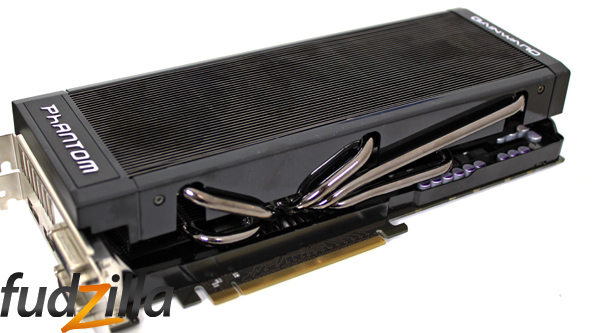
The heatsink features clean design without sharp edges. The welds between heatpipes and aluminum fins were done well.

As we mentioned before, Phantom’s cooler is equipped with two fans but two fans share the same 4-pin power connector. However, this is not as important because the driver will take care of setting the same RPM for both fans. Setting the RPM manually is a breeze using Gainward’s ExperTool or any other popular utility like MSI Afterburner or EVGA PrecisionX.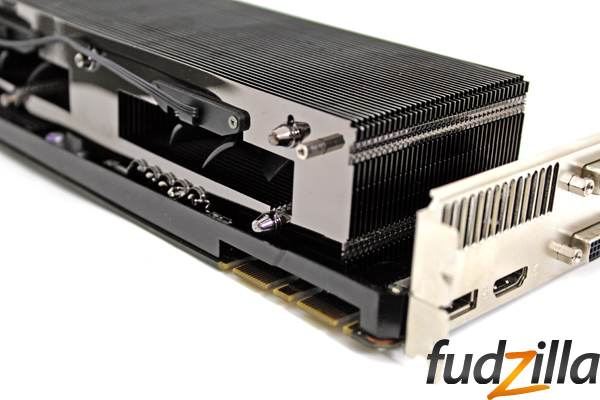
The next picture shows how cable routing was implemented.
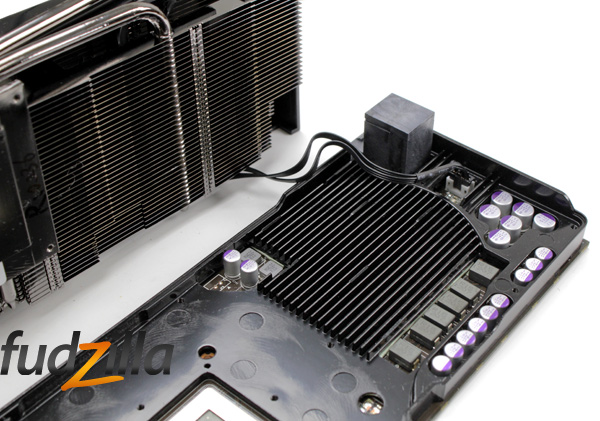
Pulling cold air through the heatsink is the main task for the fans, but they are in charge of cooling hot components on the PCB too. As you can see from the picture, the big metal plate covers all the shorter electrical components on the PCB, such as memory modules.
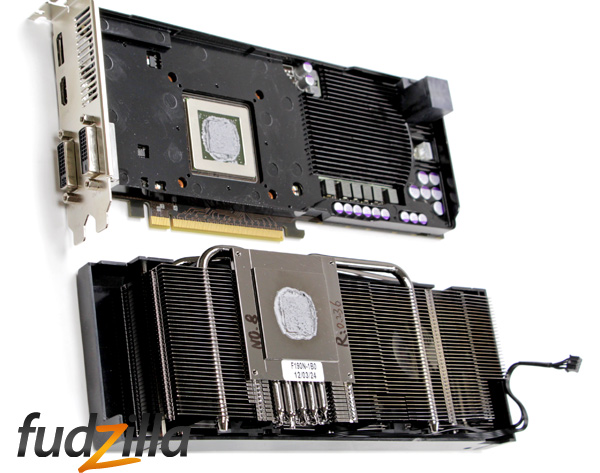
GTX 680 Phantom is equipped with a total of 2048MB GDDR5 video memory.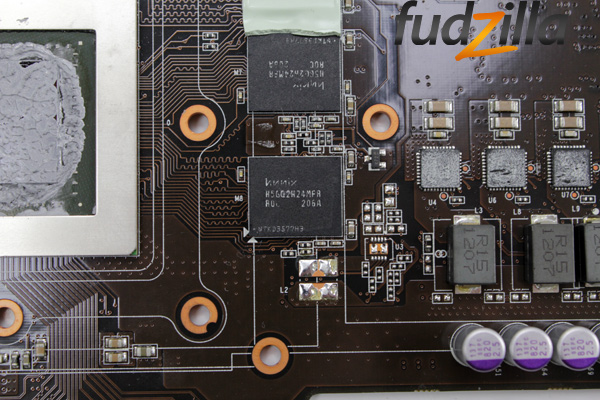
As far as video outs go, we have here the classic Gainward’s Quattro-ports design, i.e. two dual link DVIs, HDMI and DisplayPort out.
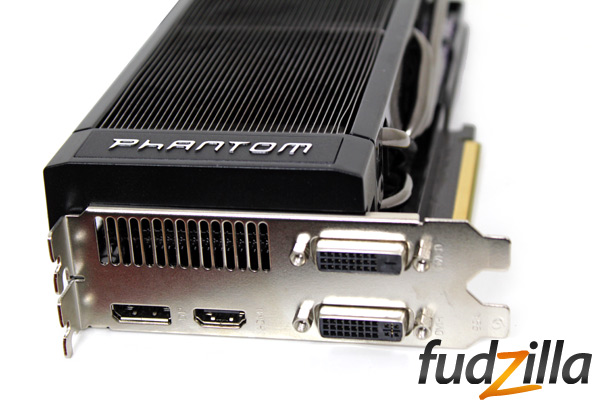
Note that all four video outs can be used simultaneously. Nvidia included an HDMI sound device within the GPU, so there is no need for connecting the card to your motherboard’s/soundcard’s SPDIF out to get audio and video via HDMI.
Unlike the reference GTX 680, which uses two 6-pin power connectors, Gainward’s juiced up card will require one 8-pin connector and one 6-pin power connector. Gainward adds two extra phases for power supply for GPU core that helps to supply more fuel to the overclocked graphics engine and share the current load with other four phases to reduce the max operating current.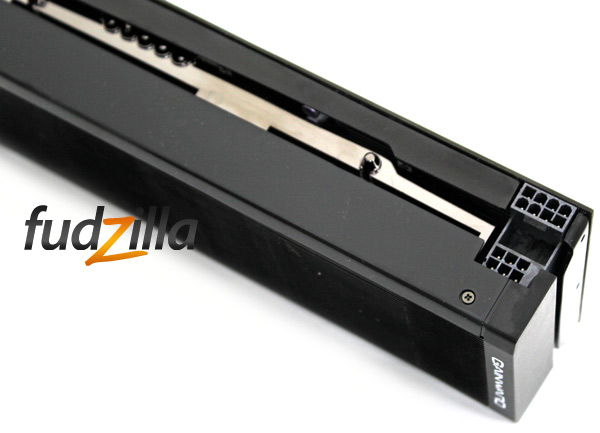
Motherboard: EVGA X79 FTW
CPU: Sandy Bridge-E Core i7 3820 (3.6GHz)
CPU Cooler: Thermalright HR-02 (Thermalright-Europa Distri www.PC-Cooling.de).
Memory: 8GB ADATA DDR3 1600 XPG Gaming series
Harddisk: OCZ Vertex 2 100 GB
Power Supply: CoolerMaster Silent Pro 1000W
Case: CoolerMaster Cosmos II Ultra Tower
Operating System: Win7 64-bit
Nvidia 301.10-desktop-win7-winvista-64bit-english-whql
amd_radeon_hd_7800_8.95.5_win7-64
12-3_vista_win7_64_dd_ccc.exe
3DMark 2011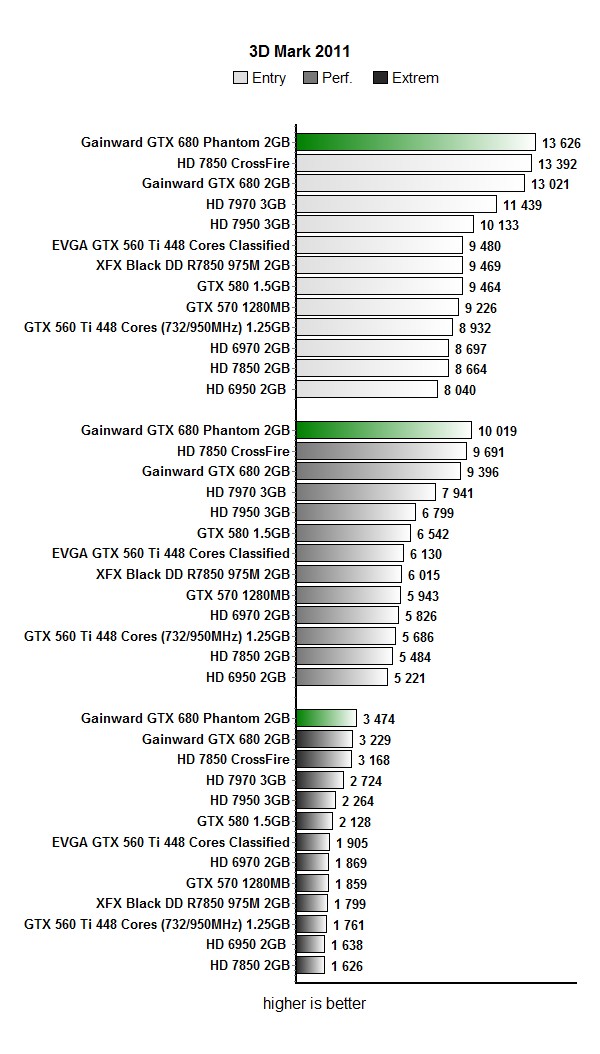
Aliens vs Predator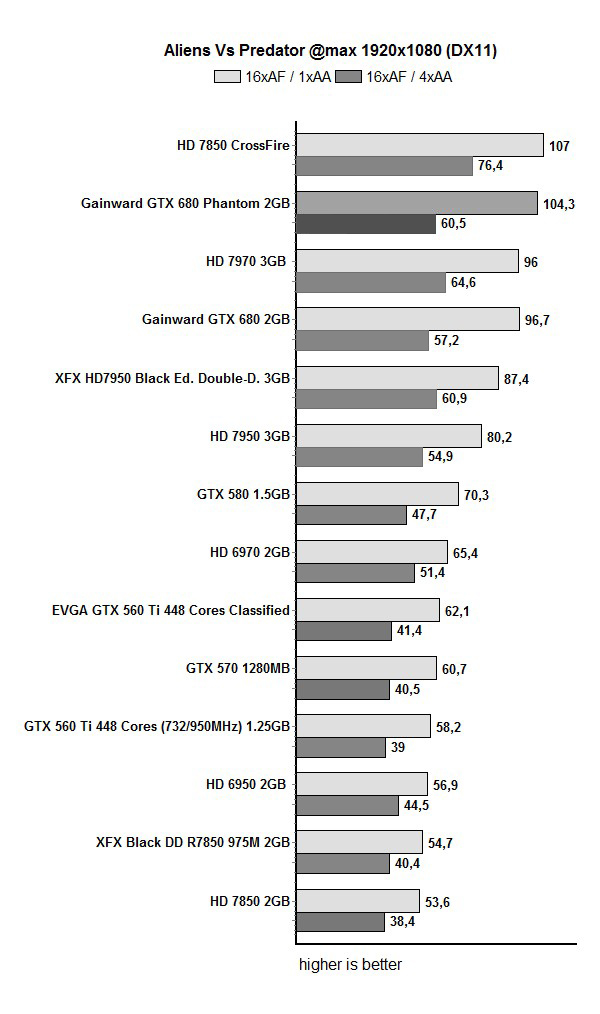
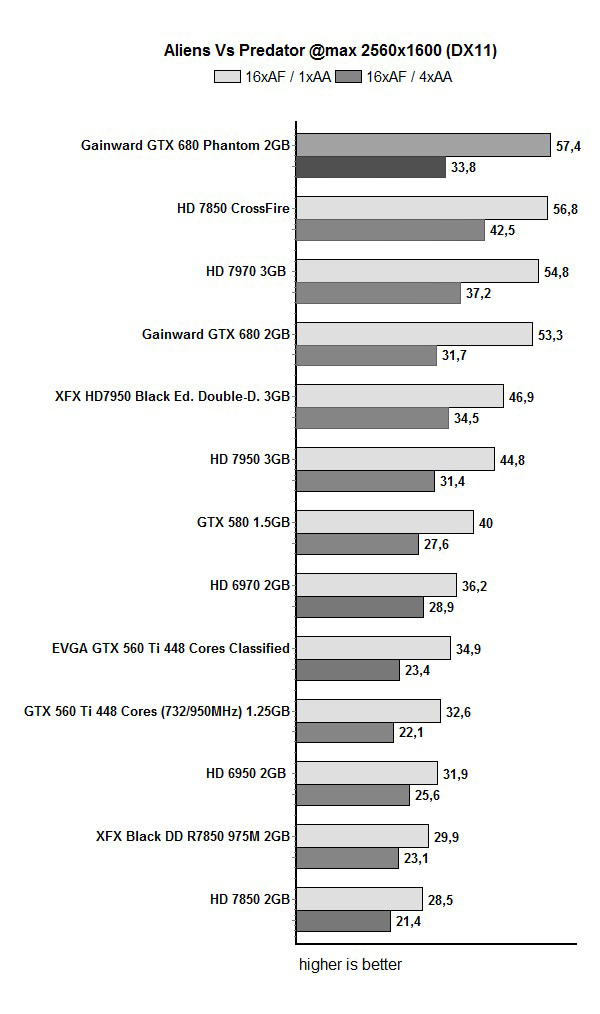
Metro 2033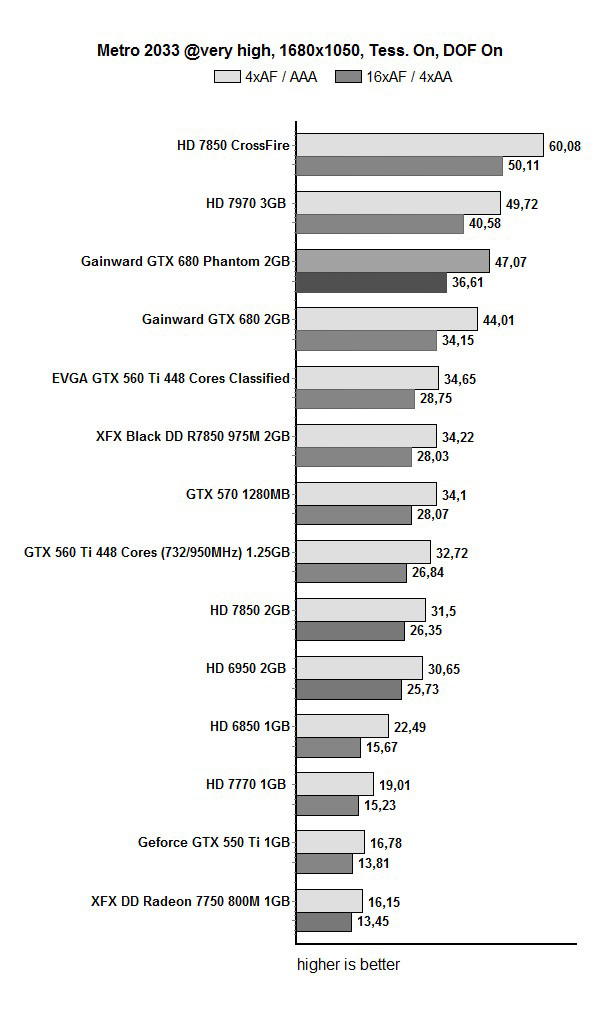
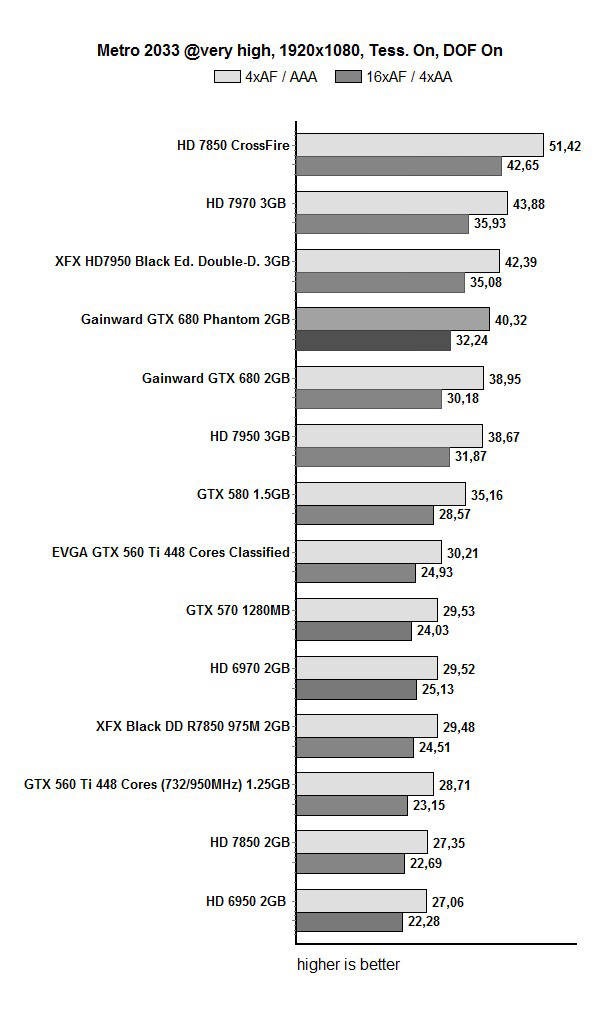
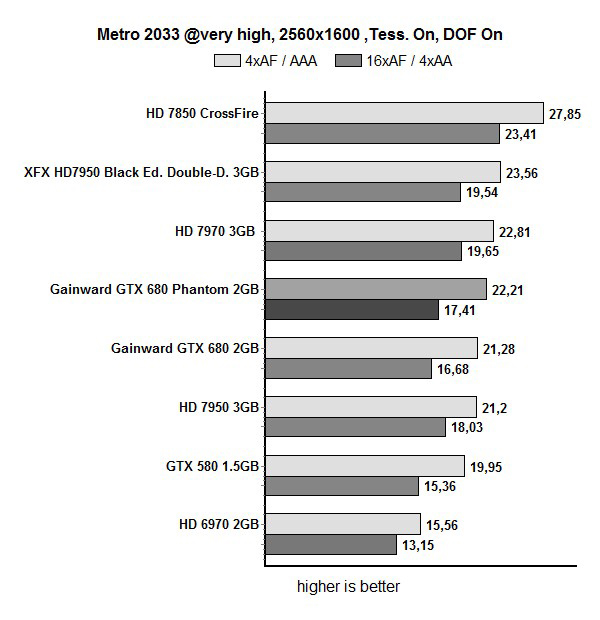
Crysis 2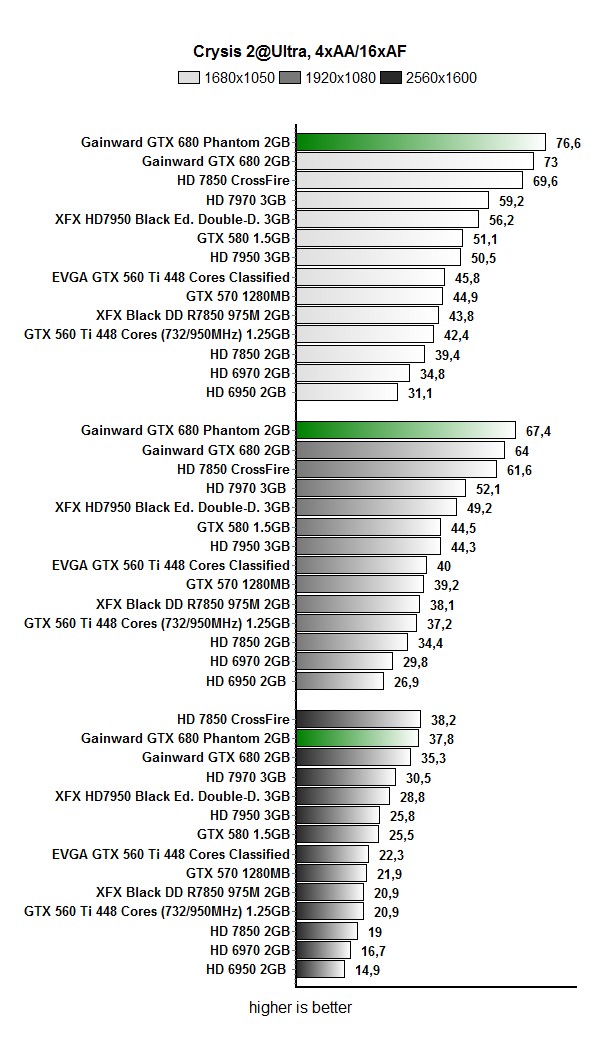
Unigine Heaven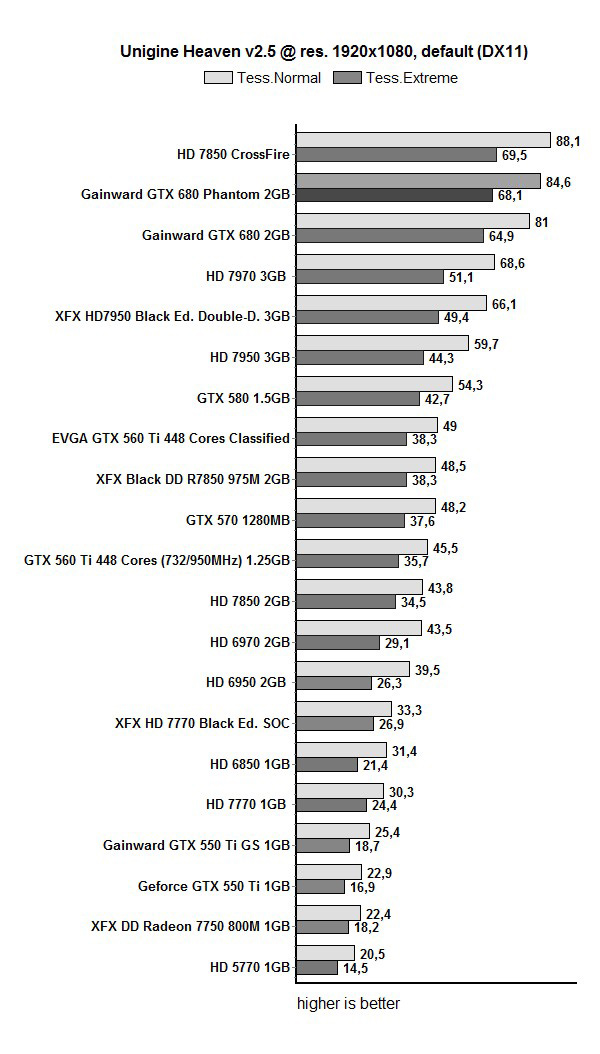
Overclocking and GPU Boost are closely related. Namely, GPU Boost is a hardware implemented feature that cannot be disabled. GPU Boost operates completely autonomously with no game profiles and no intervention required by the end user, providing an instant performance boost to gamers. This feature monitors important operation parameters and calculates optimum GPU clocks. However, although it may seem as an overclocking limiter, overclocking is still flexible enough. In fact, GTX 680’s OC potential isn’t half bad. Note that reference GTX 680 cards run at 1006MHz, whereas the Phantom’s GPU is at 1085MHz.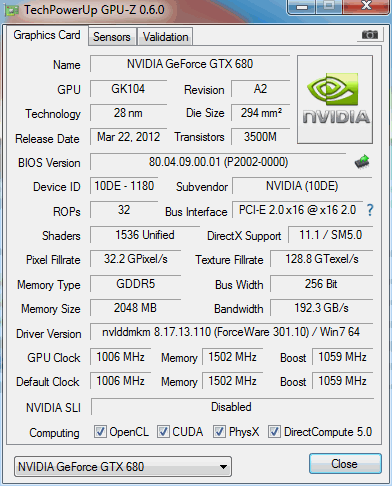
Gainward GTX 680
Gainward GTX 680 Phantom
GPU Boost is similar to Intel’s Turbo Boost. If an app or game you started doesn’t overburden the GPU, i.e. doesn’t max out the TDP and thermals, then GPU Boost will up the clock from the Base clock to Boost clock and thus improve performance.
Shader clock is something that Nvidia abandoned with Kepler, but now we have other two clocks worth noting – “Base Clock“ and “Boost Clock“.
The Boost Clock is the average clock frequency the GPU will run under load in many typical non-TDP apps that require less GPU power consumption. On average, the typical Boost Clock provided by GPU Boost in Geforce GTX 680 is 1058MHz, an improvement of just over 5%. The Boost Clock is a typical clock level achieved while running a typical game in a typical environment.
However, in many cases the GPU will have additional power headroom available and will automatically increase the Boost Clock even higher than 1058MHz. As long as the GPU remains under its power target, GPU Boost will seamlessly increase the GPU Clock. We measured maximum GPU clock of 1110MHz on Gainward’s reference GTX 680 while Phantom’s max was 1189MHz.
Playing Crysis 2 at reference Base clock resulted in 13 different GPU clocks, starting from 1006MHz and ending with 1110MHz 1006/1019/1032/1045/1058/1071/1054/1097/1110MHz). So, overclocking Kepler GPUs won’t provide stable and fixed OC clocks, since the GPU Boost feature produces a range of OC clocks.
While playing at 2560x1600, we noticed that clocks change almost every few seconds, whether it was downclocking or overclocking. Note that the sole exception was 1110MHz as we didn’t see it at this resolution. After we lowered the resolution to 1920x1080 and then 1680x1050, we noticed that clocks remain unchanged longer. In fact, 1280x1024 resulted in almost constant 1097MHz. This clearly shows that GPU Boost gets quite busy when the workload is higher, since it has to intervene and keep the operation parameters within normal limits. This is why it’s difficult to say what the maximum clock is, because although it can run stable some time, it doesn’t mean it will remain fixed after few hours of gaming.
Overclocking the GPU within Precision X overclocking tool uses two sliders” “GPU Clock Offset” that affects the Base clock and Boost clock, whereas the “Power Target” slider moves the TDP threshold, which in turn enables higher Base and Boost clocks. Note: This setting only applies to 600 series graphics cards. Power Target is a power limiter. Increasing the Power Target will increase the available power to your graphics card, allowing for higher overclocks, or higher boost clocks.
You overclock by setting an offset value, this value is + or – every prequalified clockspeed. EG: If your Boost clock is 1058MHz, setting a +100MHz offset will make your Boost clock 1158MHz. Our additional “overclocking” resulted in +80MHz offset for the Base clock, i.e. maximum clock of 1269MHz.
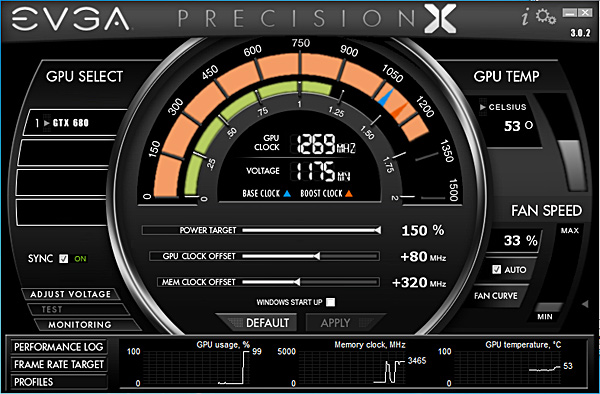
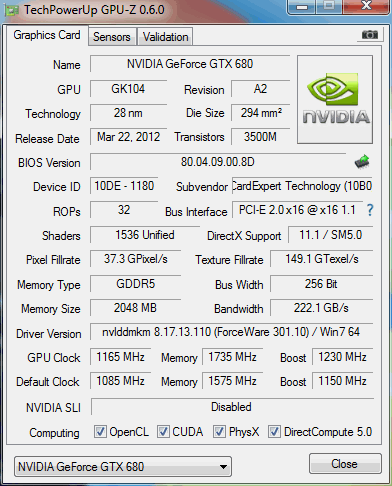
Gainward GTX 680 Phantom’s OC result
The overclocking we’re talking about was done without manual fan RPM setting, because higher fan speeds couldn’t provide better results. The fan in auto mode isn’t too loud, although it can be heard.
Precision X also provides voltage control but that didn’t help in scoring higher than +90MHz offset for the Base clock.
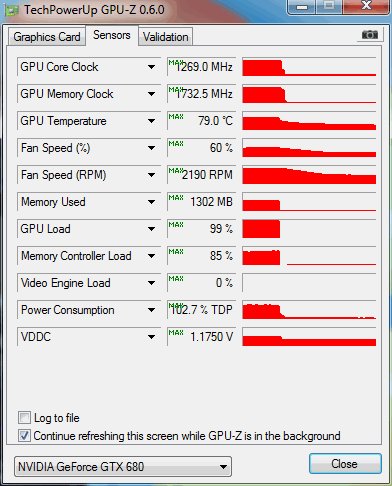
Gainward GTX 680 Phantom’s OC temperature result
Thermals and Noise
Gainward GTX 680 Phantom temperatures go up from 72°C to 77°C during gaming. This is excellent when taking into account the low noise levels. On the Gainward GTX 680 reference design temperatures go up to 80°C during gaming.
The GTX 680 Phantom’s fans are less noisy compared to reference GTX 680 ones. Note that there were no sudden changes in fan noise. However, two 8cm PWM fans tucked away in a special chamber within the heatsink does introduce one disadvantage - the card is 2.5 slots wide.
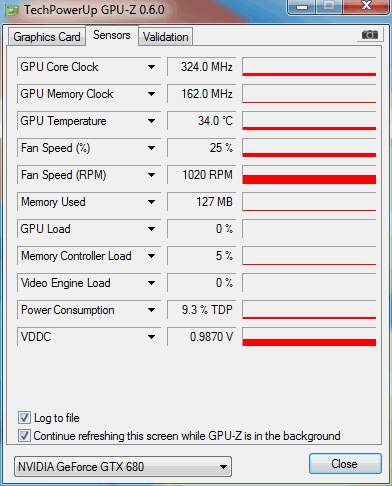
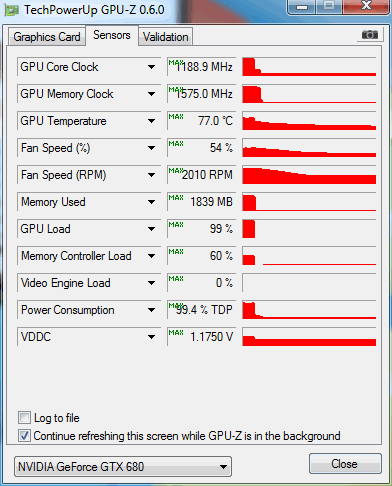
Note however the codependency between thermals and clock calculations, which may result in different performance depending on thermals. As soon as the card overheats, which causes current leakage increases, GPU Boost will decrease clocks and voltage.
Power Consumption
Gainward’s GTX 680 Phantom consumed not more than the same company’s reference version. GTX 680’s power consumption is a little better than that of its main competitor – HD 7970. However, AMD’s card boasts ZecoCore, a feature that shuts the card down once the display is off, which slashes consumption to mere 1W. The same scenario will see the GTX 680 consume about 14W. Still, GTX 680’s power management is definitely a job well done because the card scores more than 20% better than its predecessor GTX 580 while consuming 50W+ less.

Frame rate target is a function Nvidia launched with its GTX 680 series. If your favorite game isn’t very demanding and your graphics card is capable of spewing out a super high frame rate, then you can limit it to 60fps or lower. In turn, this decreases GPU temperatures, noise and your electricity bill as well.
Powerful graphics cards consume a lot of power, especially when the GPU constantly runs at full throttle. In case of the GTX 680 Phantom card, we managed to slash consumption by 20W in Aliens vs. Predator by limiting the frame rate at 60fps. The resolution in question was 1920x1080.
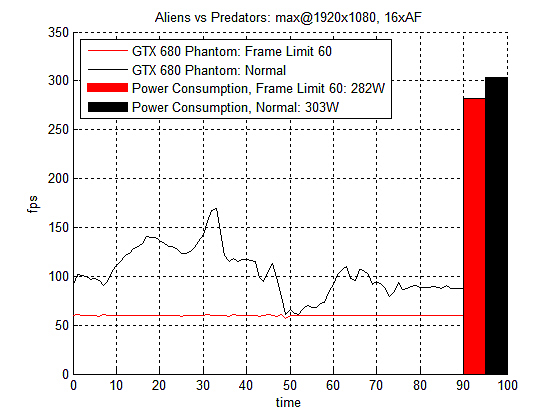
We used EVGA’s Precision v.3.0.2. and this tool allows setting frame rate target to any value from 25fps to 120fps. Note: you must restart the application for the setting to apply.
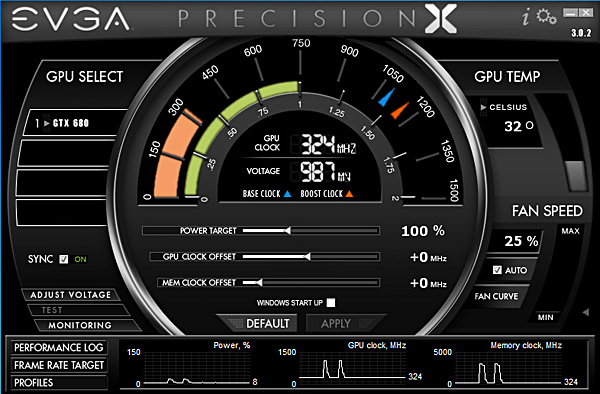
The graph we see on the picture below (left) shows the workload and consumption when frame rate target is off. On the right you see what happens when frame rate target is on. GPU was utilized to about 100% until we turned on the frame rate target option, which significantly decreased it. Additionally, consumption also went down. The values you see were measured while playing AvP at 1920x1080.

Gainward GTX 680 Phantom is a factory overclocked card with custom cooling that’s quieter and has better cooling performanse that the reference version. The factory overclock will provide you with about 6-7 percent better results than the reference card but Phantom cooling is definitely what sets it apart from the pack.
Gainward continued its tradition so the new Phantom is still dual slot, but we think most users won’t mind. We can’t pick hairs as the cooler does its job really good and it remains quiet all the time.
When playing less demanding games, users can limit frame rates, which will result in lower consumption and thermals. The reference card already boasts great consumption/performance ratio and Gainward’s GTX 680 Phantom consumes almost the same.
Power consumption and the two-display limit were a thorn in Nvidia’s backside for a while now. However, Nvidia finally addressed these issues and the GTX 680 allows for using all four video outs simultaneously.
About two weeks ago we tested Gainward’s reference GTX 680. The reference card is priced at about €475 in Europe, which is pricier than AMD’s HD 7970. Thankfully for AMD fans, we’ve seen significant price drops of HD 7970 cards and their US pricing has dropped from $549.99 to $469.99, so HD 7970 is more affordable than GTX 680. As for Europe, HD 7970 cards can be found priced at €400, which is some €60 less compared to the price we saw two weeks ago.
Bearing in mind pricing of HD 7970 cards, GTX 680 Phantom’s price of €526 seems a bit too steep. At the same time, this is about €60 more compared to the Gainward’s reference GTX 680 model. Other than that, Gainward's 680 Phantom 2GB card is most certainly a quality product that comes with special cooling and factory overclocking and will be a worthy companion for years to come.



